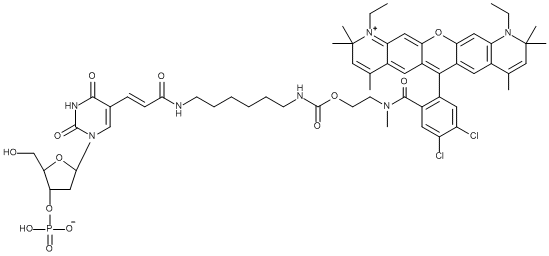CAL Fluor Red 635 dT Amidite
CAL Fluor Red 635 dT Amidite
CAL Fluor Red 635 dT Amidite, 100 μmol, ABI (5 mL / 20 mm Septum)
Key features
Show- Used to add a orange-red fluorescent dye internally or to the 5' end of an oligonucleotide.
- Maximal emission around 635 nm. Alternative to LC Red 640.
- Quenched by BHQ-2.
- Has DMT functionality.
Usually shipped in 10-15 Days, Made To Order
Product information
Historically, there was a limited selection of dyes available for multiplex PCR: TET, JOE, VIC™, HEX, Texas Red®, Cy™ 3, and Cy™ 5. In recent years, the selection and quality of reporters and quenchers has dramatically improved. LGC, Biosearch Technologies has developed the CAL Fluor Dyes, a set of fluorescent dyes specifically designed for qPCR instruments. These novel xanthene fluorophores not only replicate the applicability of previous dyes, they have further unique patented features. These dyes can be efficiently manufactured and remain stable through oligo synthesis and work up. The attachment chemistry linking the CAL Fluor Dyes to biomolecules eliminates the problem of multiple isomers. This results in dye labels that are easier to manufacture, have a single RP-HPLC peak and have well-defined emission spectra. CAL Fluor Dyes are available as CPGs and as phosphoramidites for oligonucleotide synthesis, which results in more efficient label incorporation and fewer purification steps than post-synthesis labeling. The CAL Fluor Dyes have emission maxima from 544 nm to 637 nm and can be paired with BHQ-1 or BHQ-2 for efficient quenching in a variety of probe formats. Multiplex suggestions and PCR instrument compatibility of CAL Fluor Dyes can be found here. Carboxylic acids of the CAL Fluor Dyes 560, 590, and 610 are available to use for peptide labelling.
Access support
Need some support with placing an order, setting up an account, or finding the right protocol?
Contact us